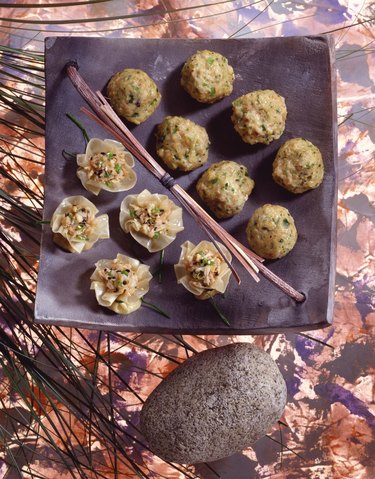
Chinese history is at the heart of a stuffed wonton wrapper. Wontons are mentioned in Chinese literature as early as the sixth century. Today, wonton wrappers serve as ravioli skins, mini hors d'oeuvres wrappers and chips. Their universal appeal rests in their simplicity: A plain square of thin dough you can stuff with anything, cook however you wish or slice into ribbons and toss into soup.
Wonton Upon a Time
Video of the Day
North China is the birthplace of wonton wrappers, where they began as stuffed, sealed dumplings called jiao-zhi. Jiao-zhi refers to currency; during the New Year, citizens ate dumplings as a metaphor for eating money, acting out their hopes for prosperity in the coming year. Wheat flour and water comprised the original ingredients of their wonton wrappers. In the south, especially in and around Shanghai, wontons swiftly gained in popularity, and wheat flour, eggs and water made up their core ingredients. The Tang Dynasty found wontons distinguished by the shape of their wrapper, square as opposed to round, which was the shape of traditional dumpling wrappers. After that, wontons took on their own life and a multitude of regional variations.
Video of the Day
Rapt Attention to Wontons
Today, store-bought wonton wrappers are typically made of enriched white or whole-wheat flour, egg, water and occasionally salt, sharing this basic recipe with Asian egg noodles. At your grocer, wonton wrappers are usually in the produce section, not far from other Asian ingredients. They come in a variety of sizes, starting at 3-inch squares. When stuffed and added to cilantro and sesame oil broth, wontons are sometimes listed on Chinese restaurant menus as hun tun. They are essentially a vehicle for combining and presenting other ingredients, and as such, you can use them interchangeably with similar Asian flour-based wrappers, like slightly thicker egg roll wraps or rice papers.
Rice-Based Wonton Wannabe
If you've ever eaten spring rolls, you've eaten rice paper. Food-grade rice papers are made of rice and tapioca flour, and refer to a family of edible, papery materials used in Asian cuisines. Rice papers are square or round and require some soaking before you can use them. They become transparent after soaking. The tapioca and rice they're made of give them a certain degree of resilience, and rice papers are a reliable, gluten-free alternative to wonton wrappers.
Whip Up Wonton Wrappers
Wonton wrapper dough is a basic pasta dough: flour and water with optional eggs and salt. Just like you might prepare a rice flour pasta, mix a handful of rice flour, a scant teaspoon of xanthan gum and several splashes of water and knead until you get a smooth, stiff consistency. The xanthan gum mimics the properties of gluten, contributing volume, viscosity, elasticity and strength. You'll need to roll the dough out to a thin sheet, flouring as you go along to prevent sticking. Work quickly on a cool, dry surface and use a knife or pizza cutter to cut the desired shapes.
- Cultural China: Wonton
- South China Morning Post: History of Wonton Noodles Wins Prize
- Red Cook: Be Adventurous with Wonton
- World Nomads Journal: A Taste of China -- Simple Wontons (Chinese Dumplings)
- Bon Appetit: Rice Paper Rounds
- University of California Irvine: The Anthropology of Money in Southern California
- Gluten Free on a Shoestring: Gluten Free Won Ton Wrappers
- Gluten Free on a Shoestring: All Purpose Gluten Free Flour Blend Recipes & Information